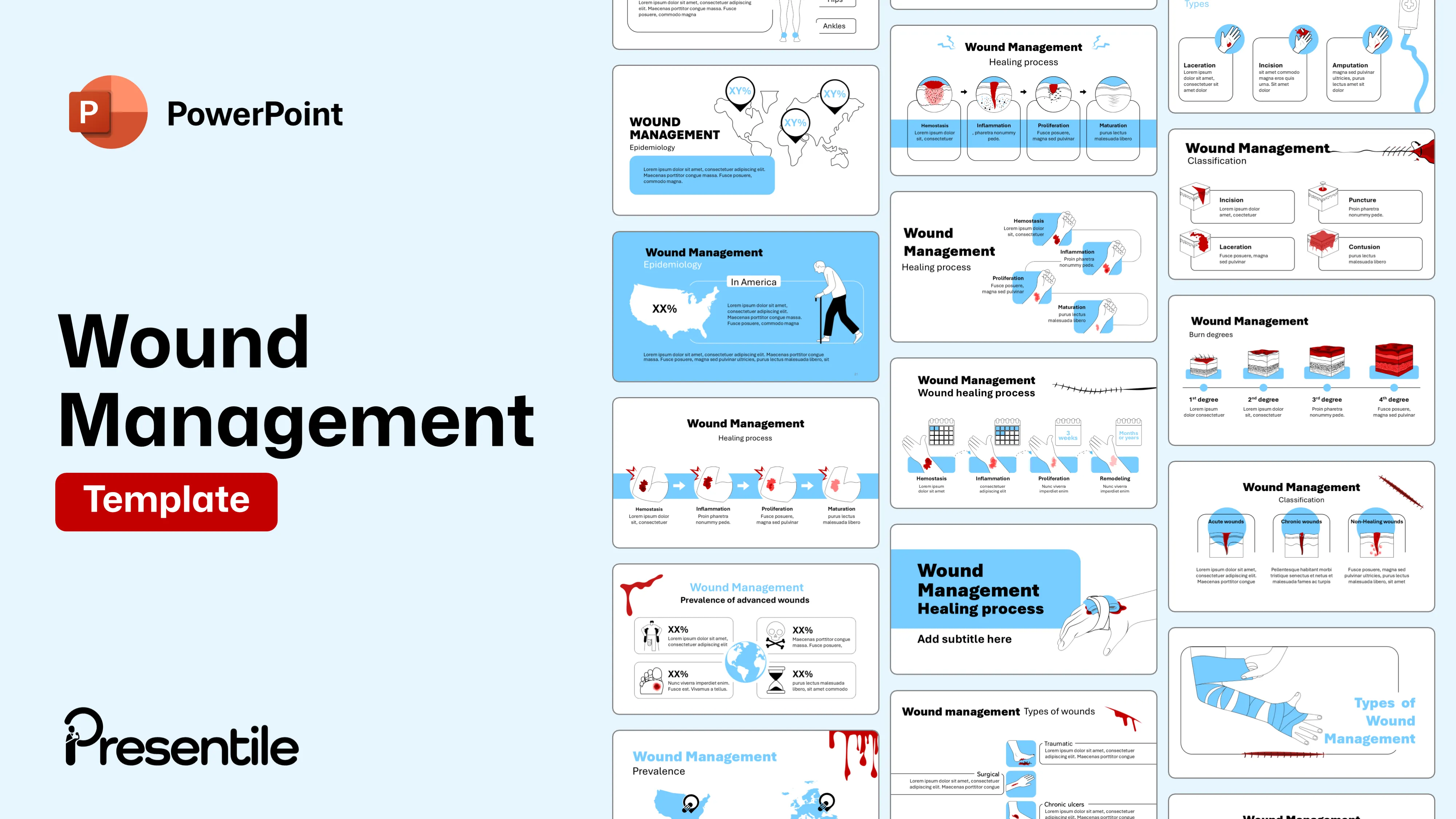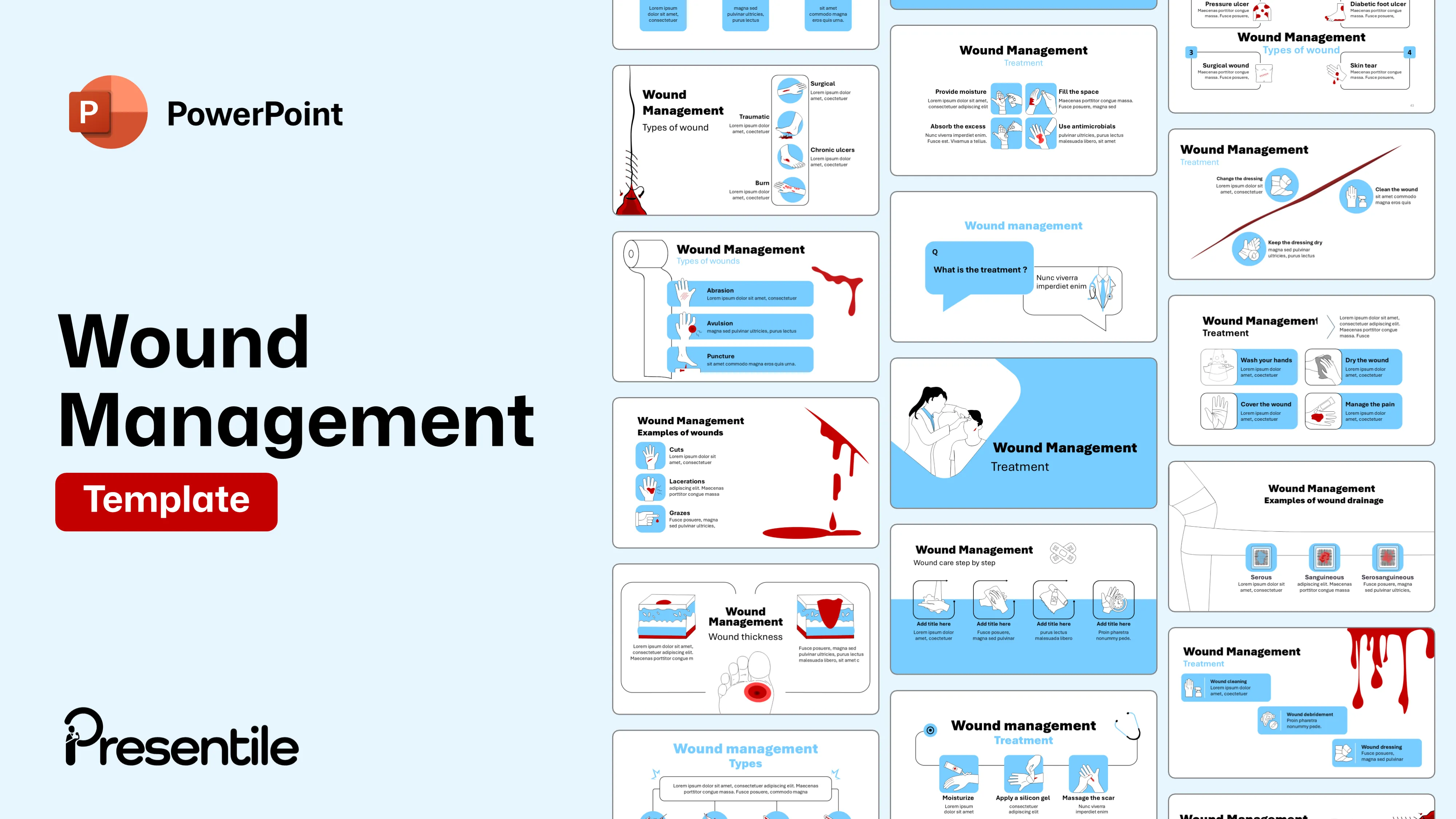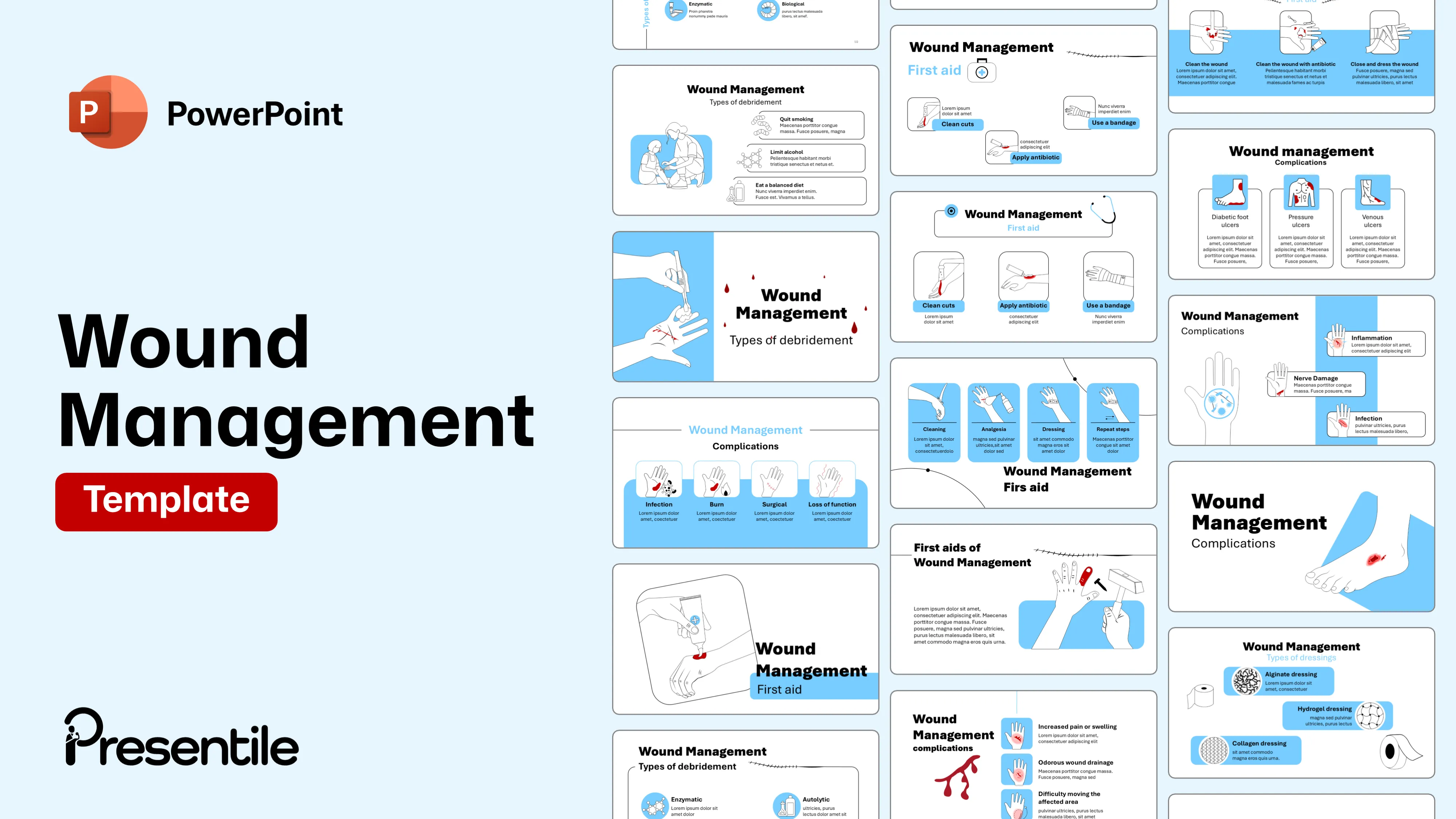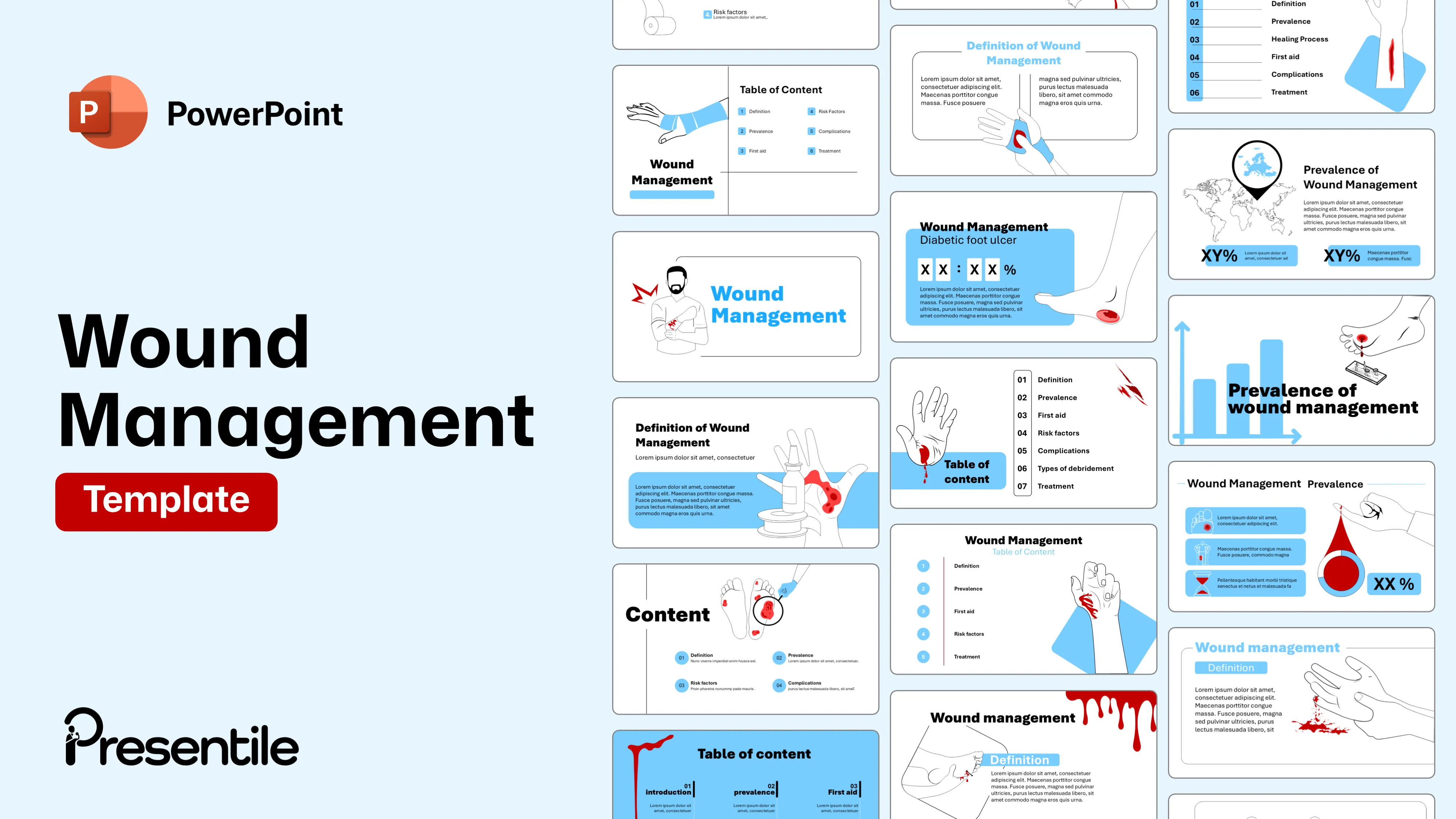
Content of
Wound Management PowerPoint Template
Wound Management Cover and Agenda Slides
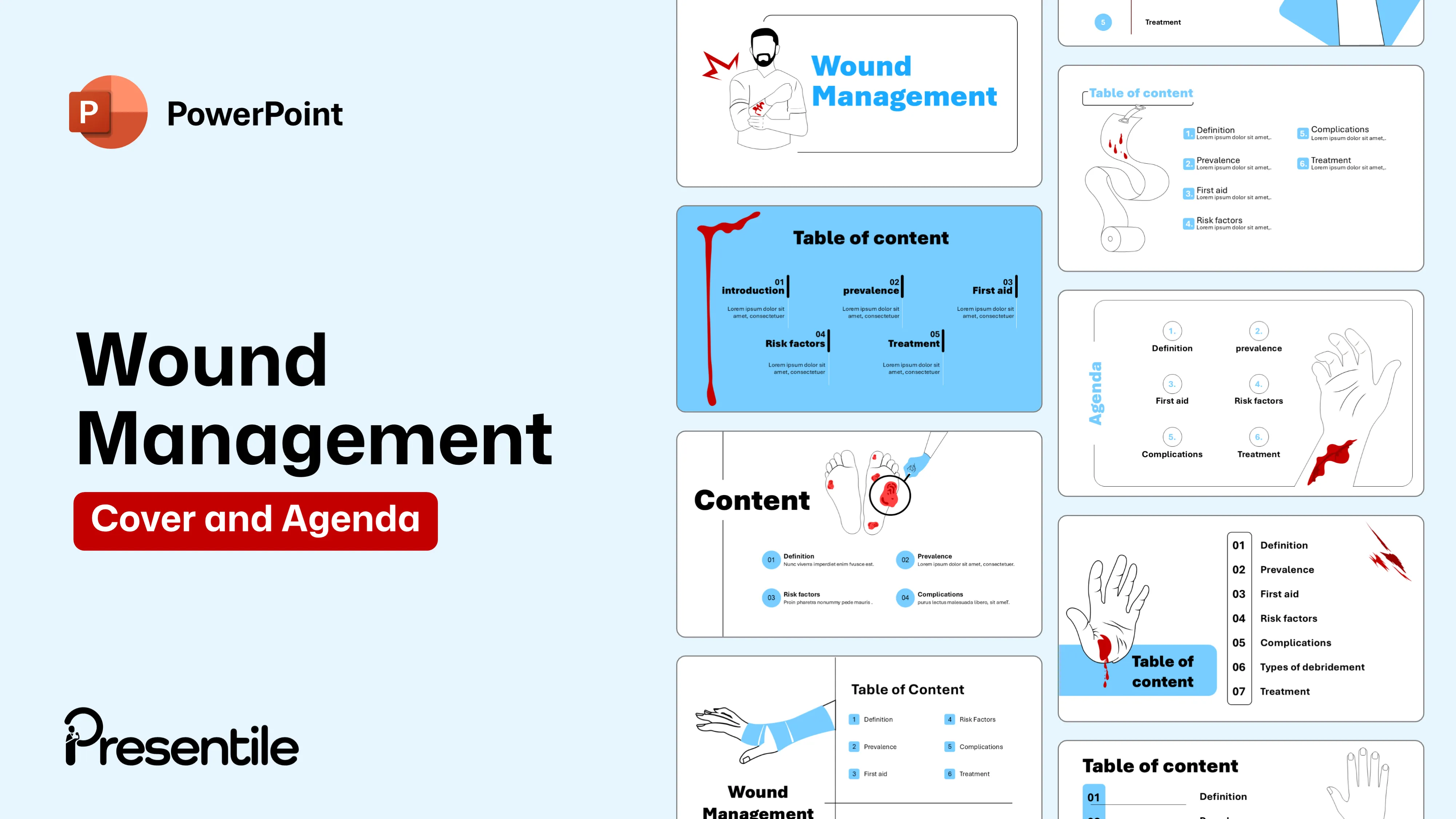
- Establish a Clear Roadmap: Choose from multiple table of content layouts that cover the full scope of wound care, including Definition, Prevalence, First Aid, Risk Factors, Complications, Types of Debridement, and Treatment.
- Use Thematic Visuals: The cover slides feature clear, impactful graphics illustrating wound sites and treatment, immediately conveying the serious and clinical nature of the topic.
Wound Management Definition Slides
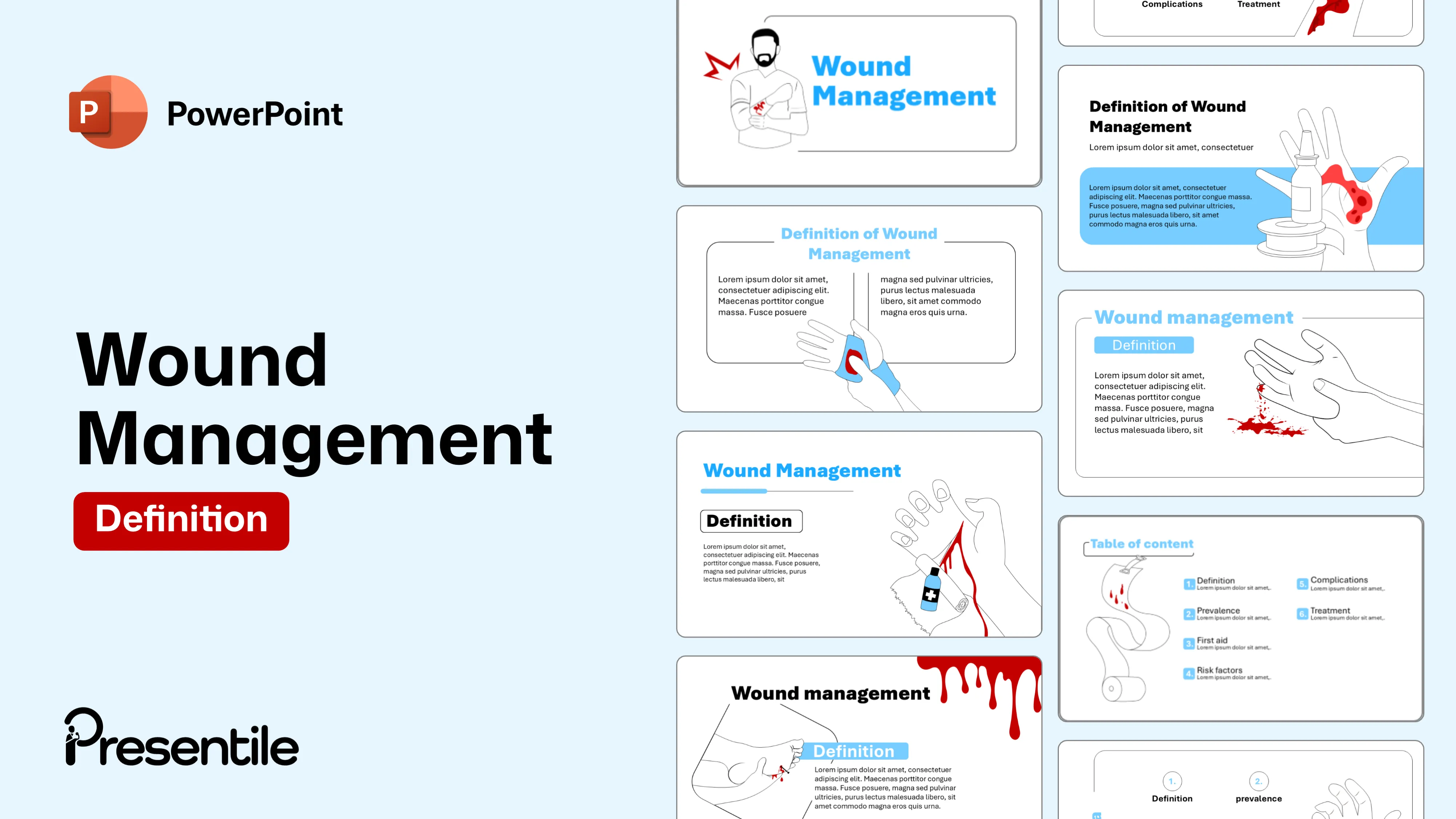
- Instantly Engage Your Audience: The large, bold cover slide establishes your topic with professional authority, immediately telling your audience they're in the right place.
- Define with Clarity: Choose from multiple distinct layouts—from clean text boxes with single illustrations to organized two-column designs—to perfectly frame your explanation of Wound Management.
- Boost Comprehension: The slides feature relevant, high-quality illustrations and vectors that support your definition. By visually connecting the text to the concept of wound care, you ensure complex medical information is understood quickly and retained longer.
- Complete Flexibility: Every text box and element is fully editable. Simply drop your concise, expert definition into the placeholder text and customize the layout to match your presentation style.
Wound Management Prevalence Slides
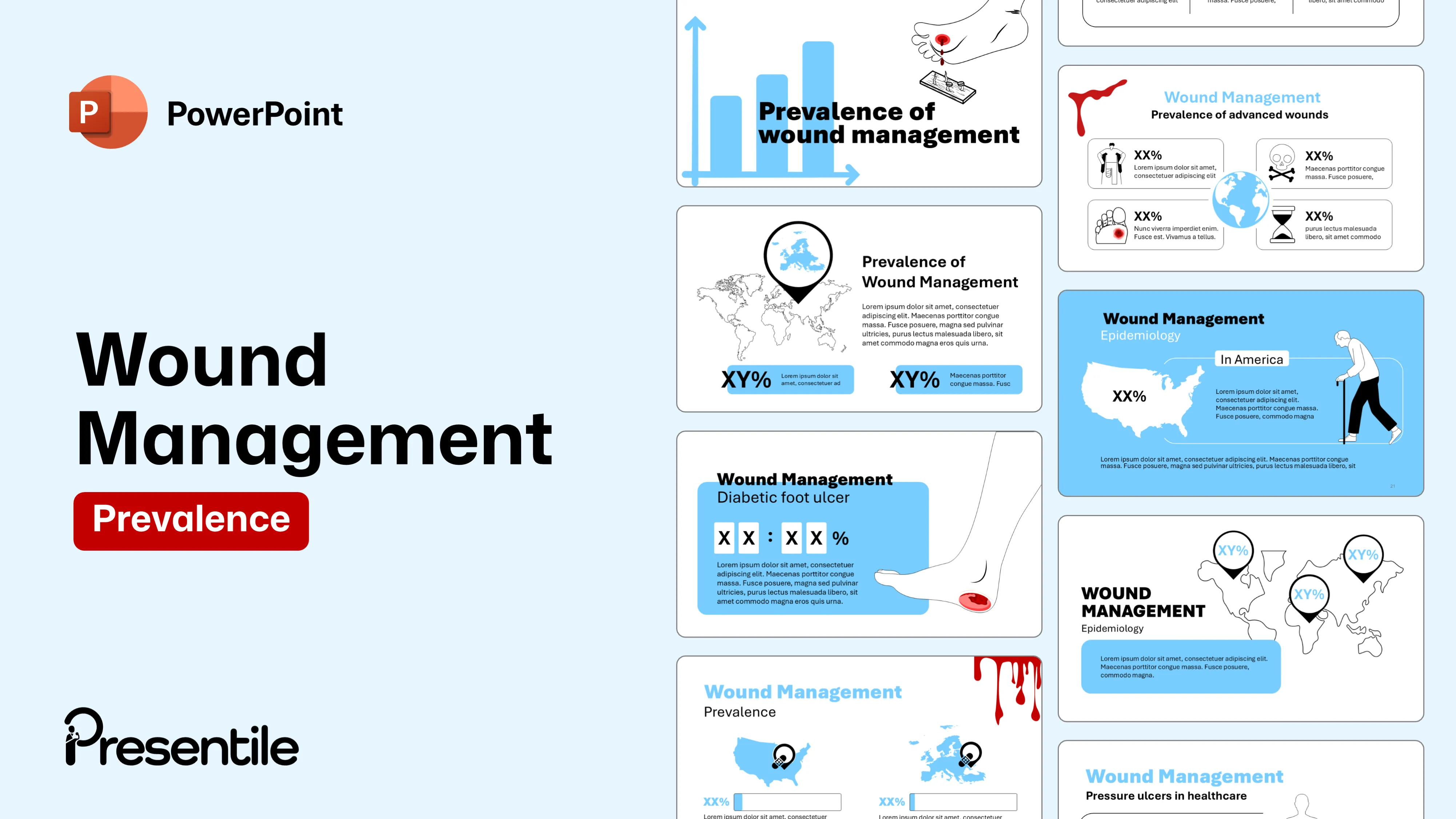
- Illustrative Data Visualization: Move beyond dry statistics! These slides feature a variety of charts, graphs, and visually engaging layouts to represent prevalence rates effectively. Whether it's comparing percentages, showing geographic distribution, or highlighting specific wound types like diabetic foot ulcers, your data will be presented with impact.
- Geographic & Demographic Insights: Easily display where wound management challenges are most pressing. With maps illustrating prevalence across different regions or countries (e.g., in America or Europe), you can highlight specific areas of concern and global trends.
- Targeted Statistical Breakdown: Whether you need to compare prevalence between different groups (e.g., male vs. female, or specific patient populations) or show the burden of certain conditions like pressure ulcers in healthcare, these slides provide the framework.
- Fully Customizable Data Points: These slides are designed for you to easily replace dummy data with your own actual statistics. Adjust colors, chart types, and text to perfectly match your research and branding.
- Highlight Key Epidemiological Data: Present an overview of wound management epidemiology with dedicated layouts that emphasize percentages and key descriptive text.
Wound Management Healing Process Slides
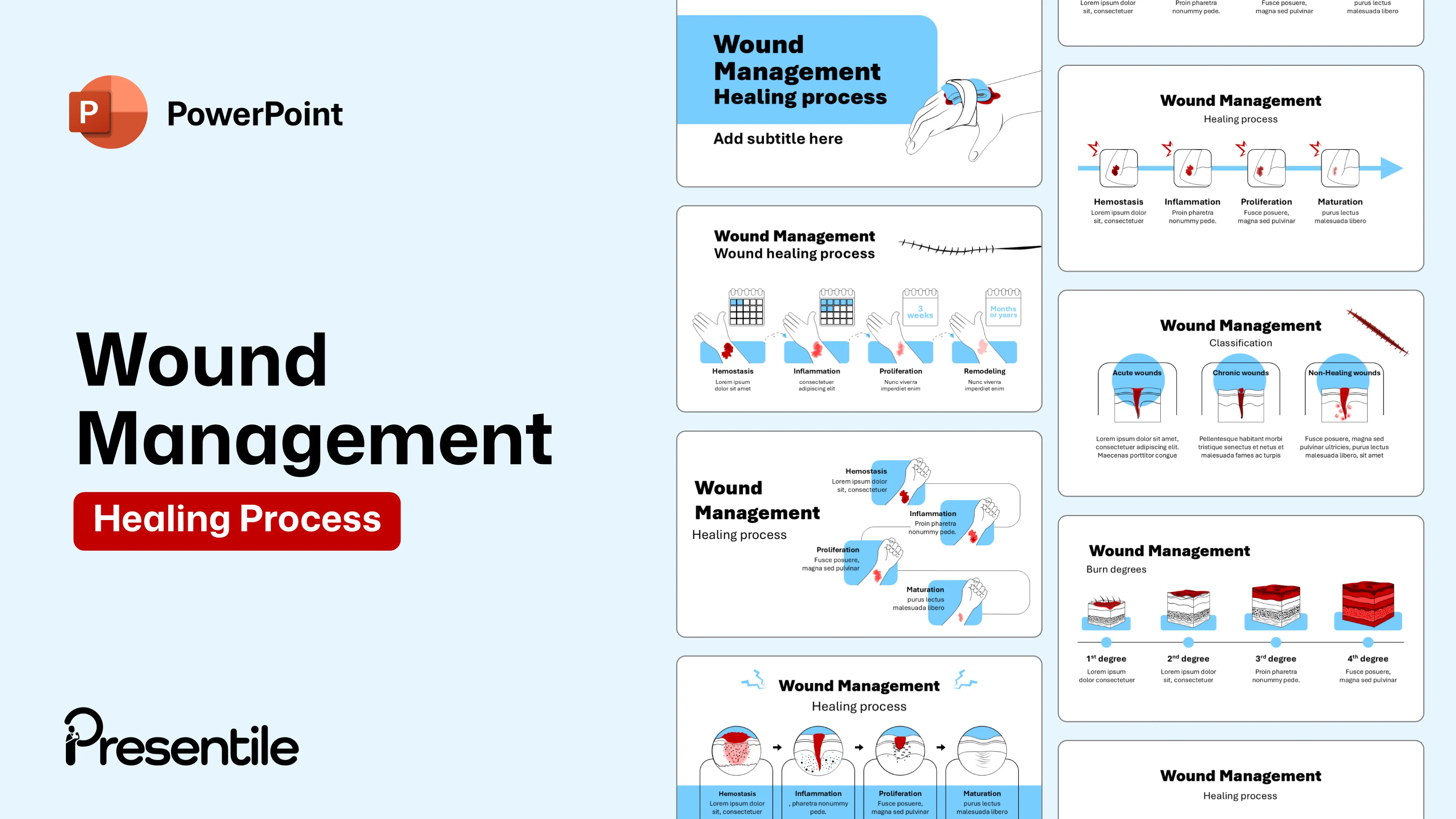
- Animated Storytelling: Utilize the layouts that clearly illustrate the four main phases: Hemostasis, Inflammation, Proliferation, and Maturation (Remodeling). The use of arrows and distinct stages makes the progression simple to follow.
- Time-Based Progression: Use the slides that incorporate a calendar or timeline visual to help your audience understand the duration and chronological nature of the healing stages.
- Detailed Visuals: Every stage is supported by clean, editable illustrations that show the physiological changes occurring, ensuring your audience grasps the science behind the treatment.
- Acute vs. Chronic: Clearly differentiate between Acute wounds, Chronic wounds, and Non-healing wounds using a visually organized layout with distinct icons and text boxes.
- Burn Degrees: Present the critical information on Burn Degrees (1st, 2nd, 3rd, and 4th) with clear anatomical illustrations that visually map the depth of tissue damage, making this crucial classification intuitive.
Wound Management Types of Wounds Slides
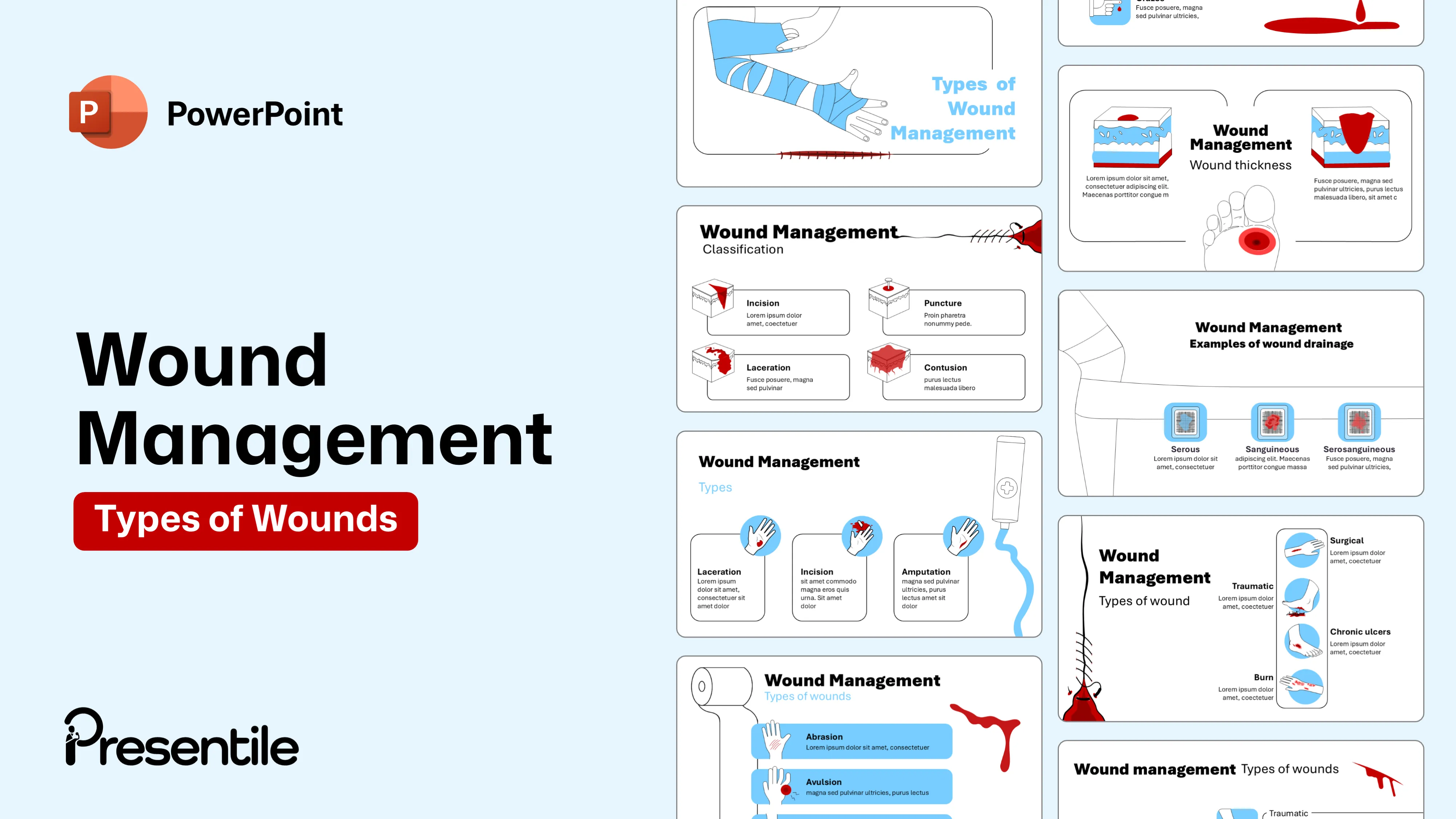
- Illustrate Mechanism of Injury: Clearly distinguish common wound types like Incision, Laceration, Puncture, and Contusion. The clean, minimalist icons instantly convey the nature of the trauma, boosting audience recall.
- Wound Depth and Thickness: Use the detailed illustrations showing Wound thickness to explain anatomical layers (like epidermis, dermis, and subcutaneous tissue). This is crucial for teaching proper assessment and care.
- Classify Wound Categories: Present various categories—from Traumatic and Surgical to Burns and Chronic Ulcers—using organized layouts that allow you to quickly define each type.
- Detail Wound Drainage: Don't leave out critical assessment details! Use the dedicated layout to explain the different types of wound drainage, such as Serous, Sanguineous, and Serosanguineous, each supported by a distinct icon.
- Comprehensive Coverage: From minor injuries like Abrasion and Avulsion to severe trauma like Amputation, these slides ensure you have a professional, visually-supported definition for every type of wound you need to discuss.
Wound Management Slides
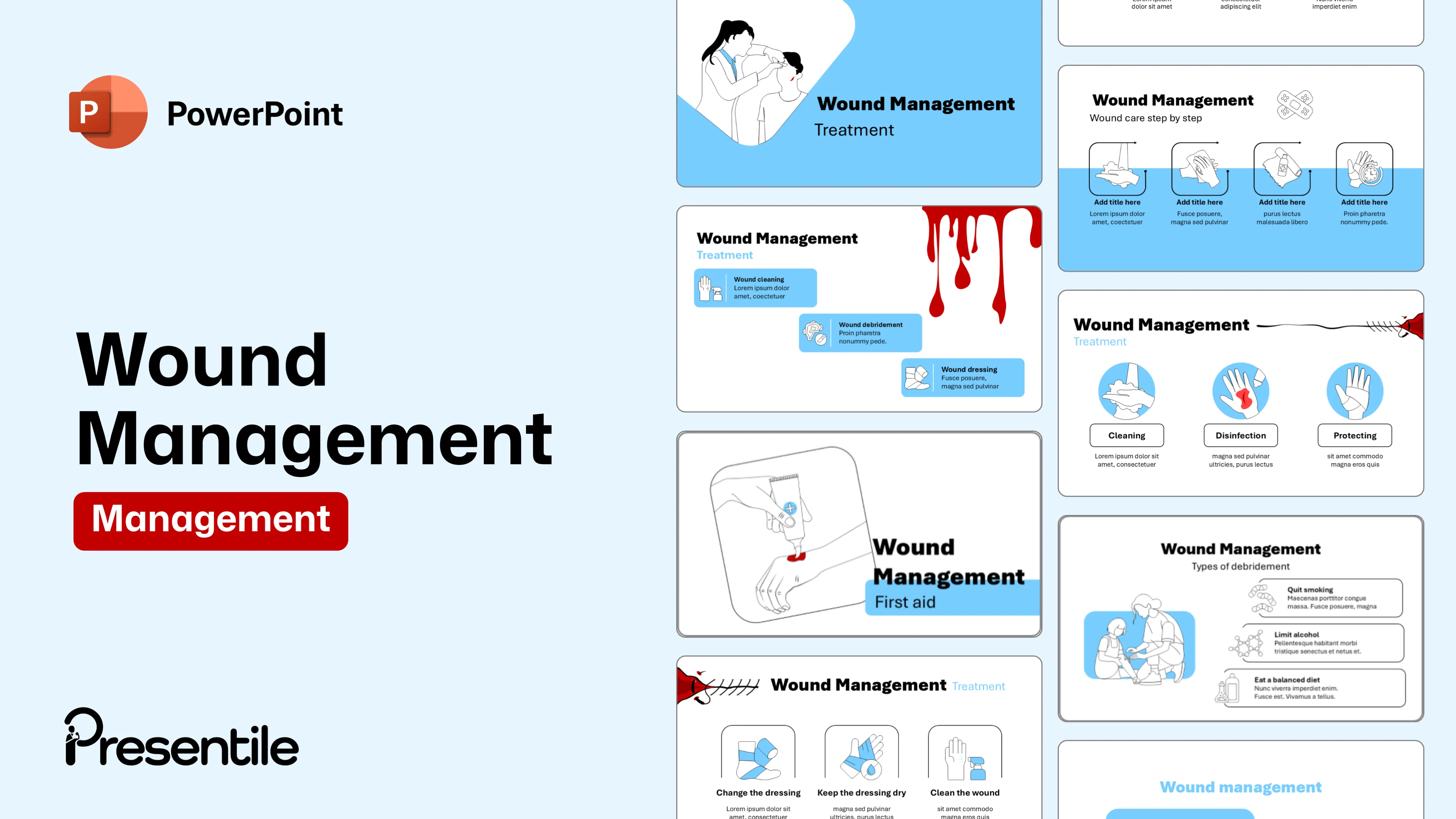
- Treatment Overviews: Use the slides that detail the general steps of Wound Care, from initial assessment to ongoing healing.
- Step-by-Step Procedure: Clearly outline the core aspects of care, such as Cleaning, Disinfection, and Protecting the wound. These distinct, icon-supported steps make protocol adherence easy to teach and remember.
- Wound Dressing Protocols: Detail the steps in managing dressings, including Wound cleaning, Wound debridement, and applying the final Wound dressing.
- Wound Care by Step: Use the timeline or process-flow layout to summarize the entire Wound care step by step, making the complete process visually coherent.
Wound Management Types of Debridement Slides
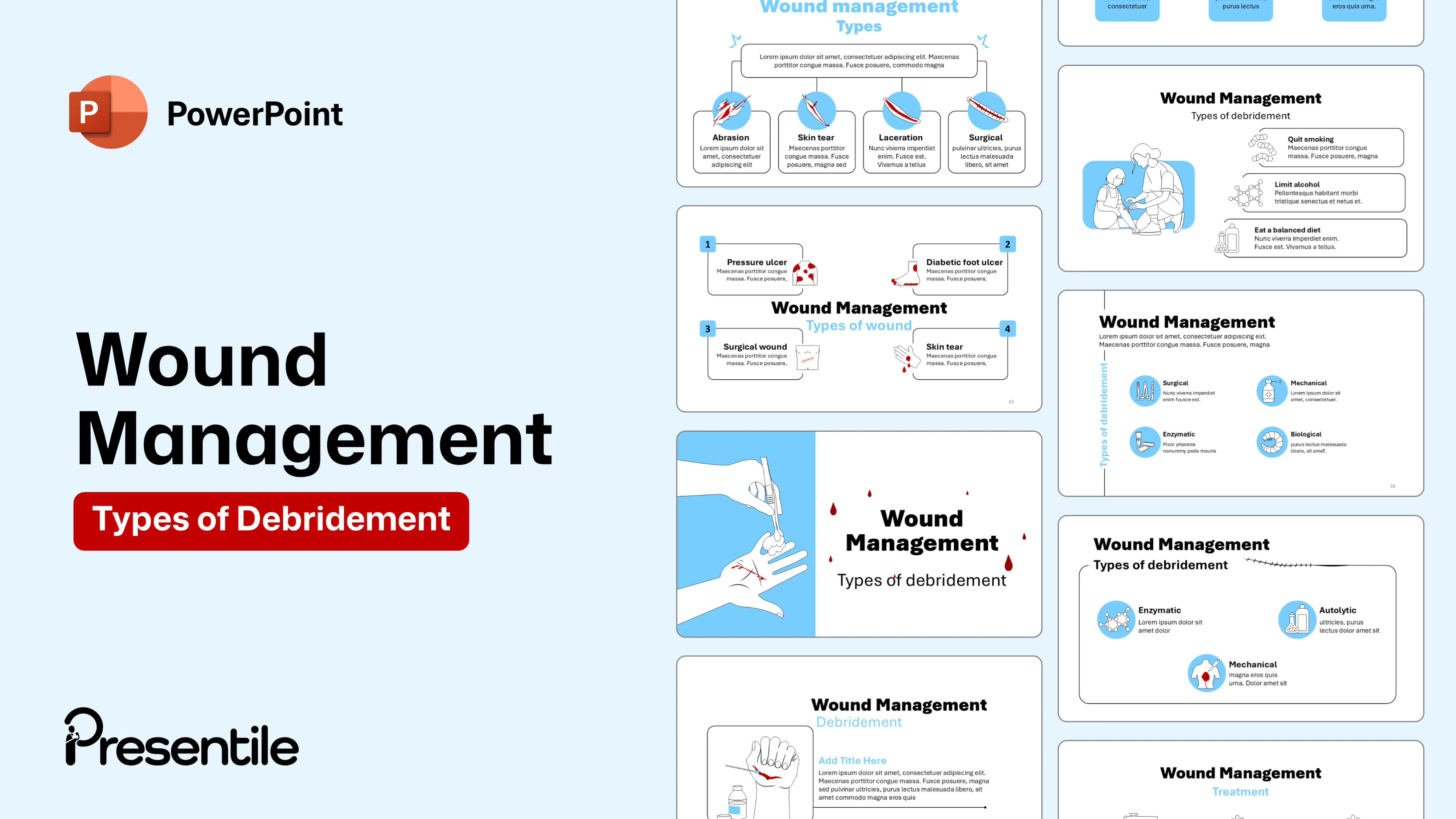
- Categorize Techniques Visually: Present the key debridement types—Surgical, Mechanical, Enzymatic, and Autolytic—using distinct icons and organized layouts. This visual separation makes it simple to teach the function and application of each method.
- Focus on the Core Procedure: Use the central, icon-supported layout to define and illustrate the purpose of Debridement itself, ensuring your audience understands why removing necrotic tissue is essential.
- Preventative Measures: Include the slide that outlines steps to improve wound healing and prevent complications, such as Quitting smoking or adopting a Balanced diet. This broadens the educational scope of your presentation.
- Clear, Editable Content: Every text box is ready for your specific, expert descriptions. Simply insert your content to explain the when and how of each debridement type.
Wound Management First Aid Slides
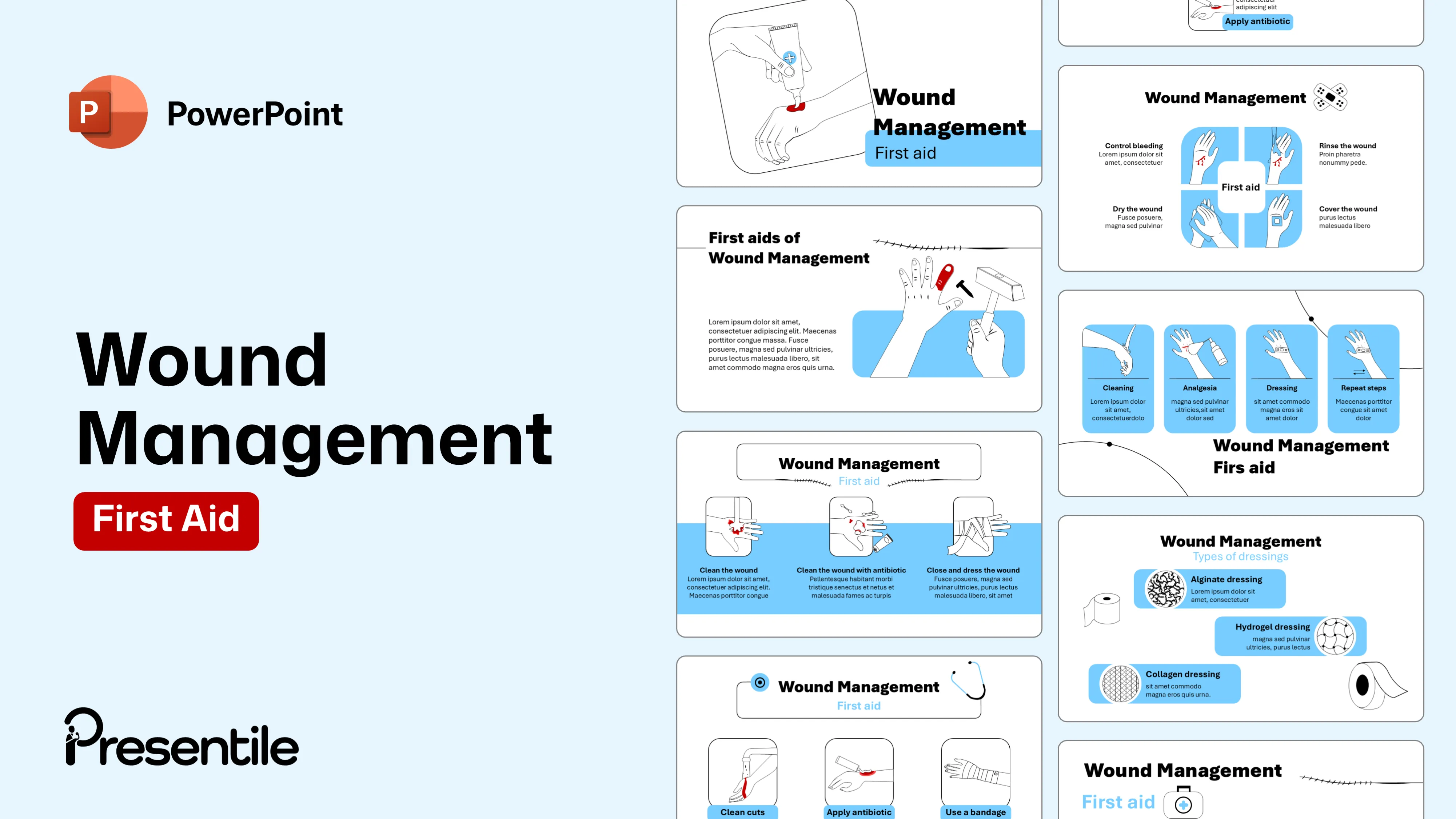
- Clear Step-by-Step Protocols: Use the dynamic, action-oriented layouts to detail the essential steps of initial care: Control Bleeding, Rinse the wound, Dry the wound, and Cover the wound. These visuals make the procedure intuitive and fast to recall in a crisis.
- Core First Aid Actions: Present the fundamental sequence of immediate care: Cleaning, Analgesia, Dressing, and follow-up Revisit steps. Each action is supported by a clean illustration, ensuring clarity over complex terminology.
- Focus on Practical Application: Utilize the slides that detail specific actions like cleaning the wound with or without antibiotic application, giving your audience practical options for immediate intervention.
- Introduce Advanced Dressings: Include the slide that introduces various Types of dressings (e.g., Alginate, Hydrogel, Collagen). This allows you to quickly pivot from immediate first aid to planned advanced care options.
Wound Management Complications Slides
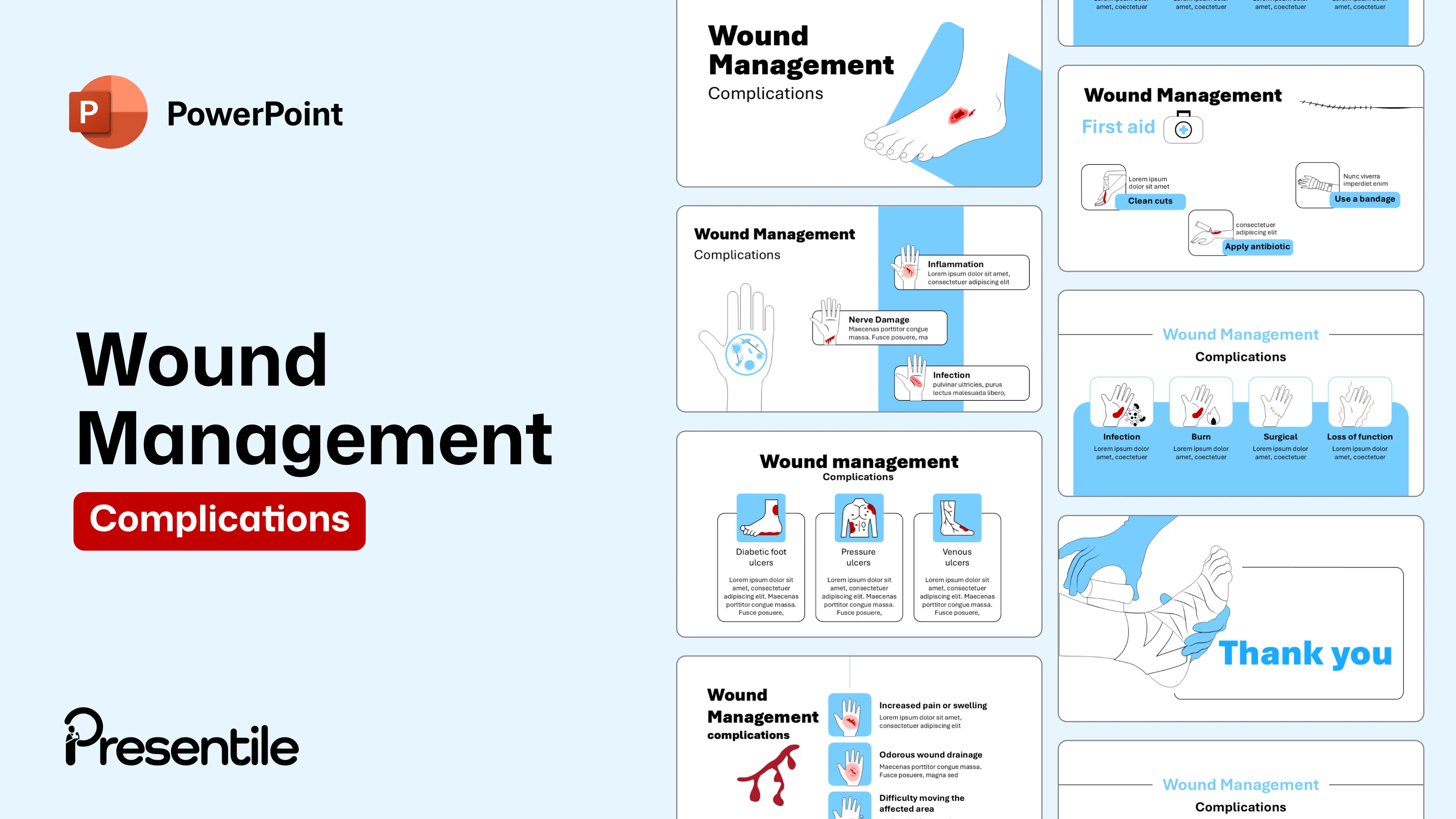
- Systemic & Local Complications: Use the distinct, illustrated layouts to categorize complications. Address immediate issues like Inflammation and Infection, as well as severe outcomes like Nerve Damage or the risk of Loss of function.
- Visualize Warning Signs: Present the signs that indicate a complication, such as Increased pain or swelling and Odorous wound drainage. The use of clear icons next to the text ensures immediate recognition of these critical symptoms.
- Identify Challenging Wounds: Dedicate slides to common problematic wound types that lead to complications, including Diabetic foot ulcers, Pressure ulcers, and Venous ulcers. This allows you to focus the discussion on high-risk areas.
- Comprehensive Coverage: Whether the complication is related to a Burn, a Surgical procedure, or a general Infection, these slides provide a visually organized structure to define and explain the causes and outcomes.
Wound Management Assessment Slides
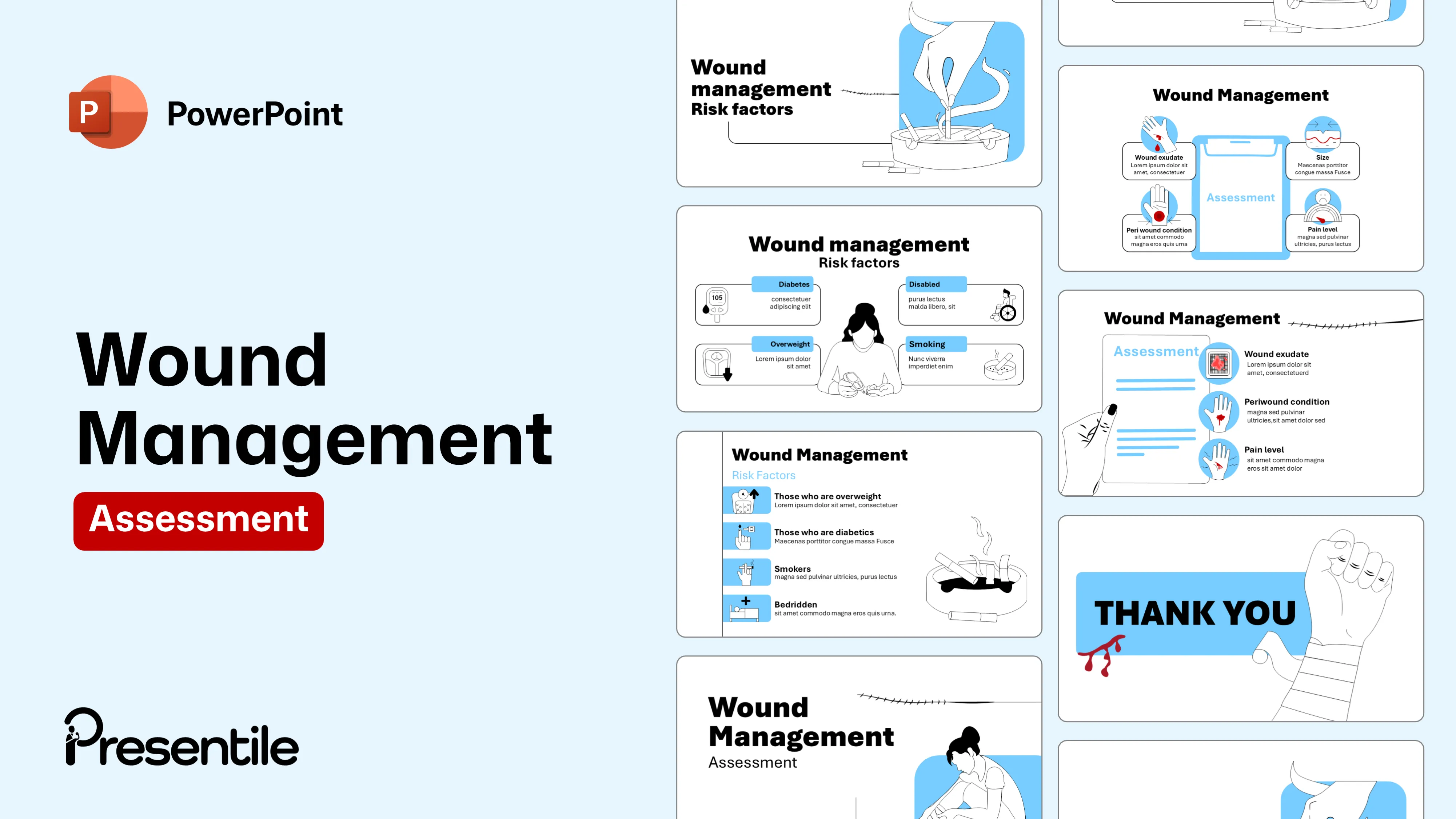
- Key Assessment Parameters: Use the clean, structured layouts to detail the essential steps of wound evaluation. Clearly outline the parameters you need to assess, such as Wound Exudate, Size, Pain Level, and Peri-wound Condition.
- Structured Evaluation: The slides break down the complex clinical judgment process into easy-to-digest visual steps, ensuring your audience knows exactly what to look for and document.
- Risk Factor Categories: Move beyond simple bullet points! Use the icon-supported layouts to clearly categorize and define major Risk Factors that impair healing, such as Diabetes, Smoking, being Overweight, and being Bedridden or Disabled.
- Proactive Care Focus: By visually emphasizing these risk factors, you empower your audience to take a proactive approach, tailoring their care plan to the individual patient's potential challenges.
Features of
Wound Management PowerPoint Template
- Fully editable in PowerPoint
- All graphics are in vector format
- Medically Referenced information and data
Specifications
 Slides count:
Slides count: Compatible with:Microsoft PowerPoint
Compatible with:Microsoft PowerPoint File type:PPTX
File type:PPTX Dimensions:16:9
Dimensions:16:9
Elevate Your Work with Our Innovative Slides
Thank you! Your submission has been received!
Oops! Something went wrong while submitting the form.
No items found.



